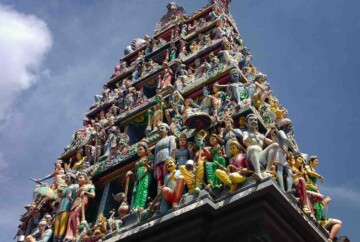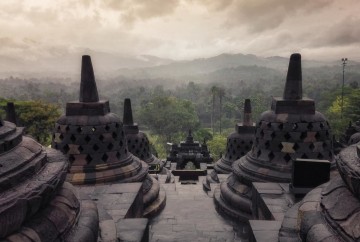When traveling abroad, get a policy from one of the best travel insurance companies. You can get a 5% discount on Heymondo, the only insurance that pays all medical bills upfront for you, HERE!
Borobudur Temple and Prambanan Temple were must stops on our trip to Southeast Asia. These two great architectural masterpieces are very close to Yogyakarta, the cultural and artistic capital of Java Island in Indonesia.
It is incredible that two temples of such beauty are so close to each other. Turns out, the simple reason behind their proximity has to do with the struggle between Buddhism (Borobudur Temple) and Hinduism (Prambanan Temple) in this area of the planet. This, in turn, benefits Yogyakarta, attracting masses of tourists who come to this place to admire these constructions.
HOW LONG TO STAY IN YOGYAKARTA
We spent two full days in Yogyakarta, besides visiting the temples, we walked through the center of the city and took the opportunity to have some rest. For those who have a tight agenda, keep in mind that you can visit the Borobudur temple and the Prambanan temple within a day – one in the morning and one in the afternoon. However, two days would be more convenient to do some sightseeing in Yogyakarta.
Also, if you are taking a trip through Southeast Asia and you pass through Yogyakarta, you can take advantage of cheap laundry service or indulging yourself in a pleasant massage. In other more popular places like Bali, these would be more expensive.

Rice paddy near Yogyakarta
TRANSPORTATION IN YOGYAKARTA
Yogyakarta has one of the best public transportation systems in Indonesia. Trans Yogya is made up of several air-conditioned bus lines that link the entire city, including the airport and the Prambanan Temple.
At each station there is a marquee where one attendant charges you the ticket price (3,000 IDR, 0.20€ approx), while another helps you pass it through a revolving door, and then another who tells you when to enter the bus. Apart from the driver inside the bus, there is an usher that tells you where you have to sit. I don’t know if this system is too efficient, but what is clear is that the system gives work to many people. Here you can see the Yogyakarta map of Trans Yogya. The bus schedule is from 6 a.m. to 10 p.m.
TRANSPORTATION YOGYAKARTA AIRPORT
The airport is one hour from downtown Yogyakarta by bus. We took the line 1A which is the one that goes through Malioboro Jalan street (main street of Yogyakarta). If you arrive at the airport at night, the price of a taxi to the center is approximately 100,000 IDR ( 7€).
PRAMBANAN temple
HOW TO GET TO PRAMBANAN temple
The best way to get to the temple is by Trans Yogya. From Malioboro street, take the bus that goes to Prambanan Temple, which is again line 1A. The bus drops you off at about a 10 minute walk from the entrance of the temple.

Prambanan
visiting prambanan temple
The entrance fee is different for locals than for foreigners. We paid 173.000 IDR (13 € approx.) per person, with the bad luck that I forgot to bring my student card, which would have been half price.
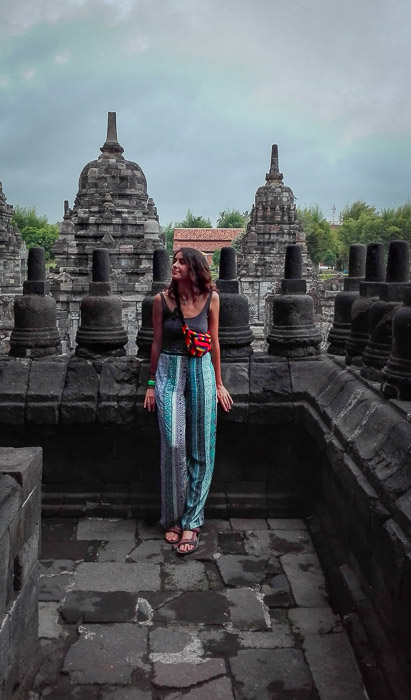
Prambanan
Prambanan is not a single temple but a complex composed of more than 200 Hindu temples that were constructed throughout IX Century.

Prambanan
Prambanan is closely related to the Buddhist temple of Borobudur since in part the earlier tried to conquer this architectural work. Prambanan symbolizes the return of a Hindu dynasty back to power after almost a century of Buddhist domination in central Java.
To celebrate, this immense complex was built where the Trimurti, the Hindu trinity, the expression of God as the Creator (Brahma), the Preserver (Vishnu) and the Destroyer (Shiva) was venerated.
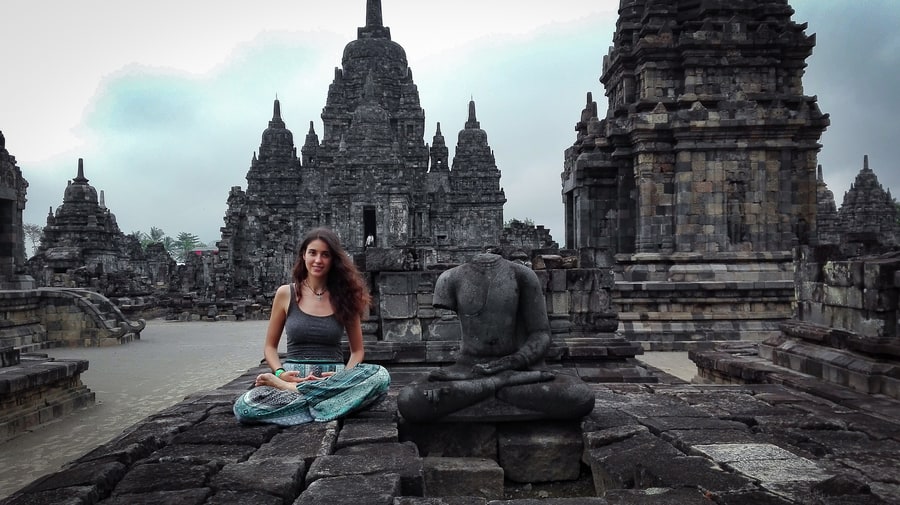
Prambanan
HISTORY OF PRAMBANAN
In the XVI century, an earthquake destroyed most of the buildings. After the disaster, the ruins were almost completely abandoned. However, there were still Hindus who came to worship the ruins.

Prambanan
In 1811, the Scottish topographer Colin Mackenzie came to the temples by chance. From then until 1880, a constant looting of the ruins was carried out. In 1918, reconstruction and restoration of the complex began. To this day, and as we could see, the work has not finished.

Prambanan
Fortunately, in 1991 Prambanan was included as a World Heritage Site by UNESCO. We hope this work of incalculable value can be preserved.

Prambanan
If you want to eat during your visit, I recommend the restaurant that is in the temple complex. Try the avocado smoothie and fried banana with chocolate and cheese.
BOROBUDUR temple
On the way back to the center of Yogyakarta, we decided that we wanted to see the sunrise at Borobudur, the largest Buddhist temple in the world and most visited monument in Indonesia. In this way, we would avoid the agglomeration of tourists that is constant throughout the day.
While there are some tours that allow you access before the temple opens, our idea was to enter as soon as the temple opens, at 6 AM, as it would still give us time to see the sunrise with no extra payment. Even though we were already staying at a hotel in Yogyakarta, we booked another hotel next to the temple so we could be there first thing in the morning.
HOW TO GET TO BOROBUDUR temple
You can get to Borobudur by bus. You have to take line 2A or 2B to Jombor, and from there another bus to Borobudur. The price of this second bus (it is no longer Trans Yogya) is about 10,000 IDR ( 1€ approx.). Remember to not give any more if they ask you. Later, we will tell you about our experience returning from Borobudur.
It takes about two hours from Yogyakarta to Borobudur in total. We didn’t look at the schedules, so when we got to Jombor, there were no buses to take us to Borobudur, but we couldn’t go back to Yogyakarta either. Finally, we had to take a taxi that we shared with other locals which then dropped us at our hotel.
visiting borobudur temple
The next morning, we were at the door of the Borobudur temple, which is only 5 minutes from our hotel, waiting in the rain for it to open at 6 am. The tickets cost 220,000 IDR (16€ approx.). For students, there is a 50% discount.
We entered at full speed trying to reach the main temple before dawn. However, the thick fog did not give us the sunrise we expected. It might be a pity given everything we did to be there so early, only to get soaked in the rain without the incredible twilight we were looking for. Nonetheless, it was worth it. We were practically alone in that majestic sacred place.
Seeing the surroundings of the temple submerged in the fog is priceless. And it is not only because of the massive construction, but also the idyllic context where it is located.

Borobudur
Unlike Prambanan, Borobudur is surrounded by thick vegetation, which isolated and helped with its preservation. This added to the majestic value of the architectural work. It is a journey toward the spirit, towards the most intimate part of oneself.
After climbing the main pyramid through its 6 quadrangular terraces, and its 3 circular ones until reaching the great bell, is an ascent towards Nirvana, the Buddhist paradise.

Borobudur
At the top, you cannot stop circling back and forth, over the platforms where the 72 bells so characteristic of this temple are located. Each of the bells has a Buddha statue inside them. Some of the bells are uncovered in such a way that we can look at all the details of the Buddha.

Borobudur
HISTORY OF BOROBUDUR
This incredible masterpiece was built between the year 750 and 850 to represent the Buddhist cosmos. During the 16th century, while Prambanan was destroyed by an earthquake, Borobudur was abandoned and forgotten until the jungle ended up devouring it.

Borobudur
It is not known for certain whether the abandonment occurred because of the damages suffered by natural inclemency (earthquakes and volcanic eruptions that covered it with ash) or the rise of Islam on Java Island.
What we do know, is that it was totally forgotten. It was in 1814 when the English ruler Thomas Stamford Raffles who rediscovered it 3 years after the Prambanan reappeared.

Borobudur
In one of his expeditions, he heard of this temple. It took 200 men and two months to make their way through the jungle to unearth the temple covered almost entirely by volcanic ash. Imagine how those men felt when they finally climbed into Nirvana.
The damage was such that the temple was at risk of collapse.
However, restoration work did not begin until the 1970s. It was when UNESCO included the monument in its plans of conservation of the Patrimony of the Humanity.
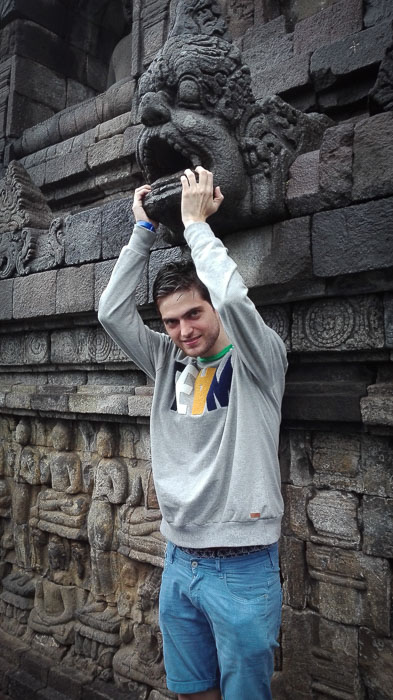
Borobudur
OUR EXPERIENCE ON THE RETURN bus
During the return trip to Yogyakarta, we had an incident with the bus that goes to Jombor. The bus wanted to charge us more than the normal 10,000 IDR normal price. After seeing that we were not going to give in for more money, they agreed to charge us only 10,000 IDR. Throughout the trip, two other collectors came to ask us for more money. We refused at the risk that they would make us get off before the destination. We spent a very uncomfortable amount time without knowing if they would let us get to Jombor or not. This seems to be very common on this journey.
That, however, did not spoil what we experienced that morning. If you have the opportunity, visit these two wonders of the world, they will not be forgotten in your memories.
OTHER THINGS TO DO IN YOGYAKARTA
As I said (if you get up early), you have time to visit Prambanan and Borobudur in a day. However, it is more convenient if you take more time to explore it thoroughly, as there are other things to see and to do in Yogyakarta and surroundings.
enjoy A MASSAGE
Yogyakarta is an ideal place to enjoy a massage since the prices are very good. We tried at Monggo Relax, where we paid 6 € for a 30-minute massage. We liked the site and the treatment so we recommend it.
After getting this message, Balinese massages disappointed us a little. We prefer this one to the one we had in Bali.
LOOK AT MALIOBORO STREET STORES
In your visit to Yogyakarta, it is essential that you walk Malioboro Jalan street from top to bottom and let yourself be seduced by its Arab style shops, bargains, souvenirs, bazaars … They have everything. You will then understand why this street is the nerve center of the city.
VISIT THE KATRON
At the end of the Malioboro Jalan street, you will be near the Katron (the Sultan’s Palace). The province of Yogyakarta is the only one in Indonesia that still maintains a sultanate. The current Sultan is Sri Sultan Hamengkubuwono X. And as he continues to live in the Katron, you will have to do it with a guide if you want to visit his palace.
The entrance price is 13,000 IDR (0.80 €) and the schedule is from 07:30 to 13:00, and Friday until 24:00. Visiting the main building is not so interesting, since you are not able to visit too many rooms as they are for the Sultan’s personal use. It is a good idea to visit the surroundings and get to know the more traditional life that is enclosed by its walls.
The Taman Sari (the water castle) is also nearby. These gardens used to be a recreational place for the Sultan although at present they are quite deteriorated.
PINUS PENGGER
And to finish, if you want to disconnect from the city, there is nothing like visiting Pinus Pengger. It was a pity to learn about this pinewood in the mountains, just half an hour from the center of Yogyakarta, after we had already left. This is definitely, a place that we signed up for our list of things to do on our next visit to Indonesia.
The most iconic of this place are hand made of pieces of wood where the best sunsets of Yogyakarta are seen. I leave you an image so you can see what I’m talking about.
Although sunset is the best time to visit it for the views, we read that it is very crowded at this time and you will have to stand in line to take the photo. The price for entering the pinewood is 2,500 IDR (0.20 €).
20 minutes to the south, you will find Jurang Tembelan, another ideal place to see the sunset as well, or to see amazing views. I left another image for you to choose which one you like the most.
WHERE TO EAT IN YOGYAKARTA
With so many excursions to the temples, we almost didn’t stop to eat. However, in the center of Yogyakarta, I recommend that you go to the restaurant Kedai Rakjat Djelata, on Dr. Sutomo Street No.54 for dinner.
The place is very well decorated and is usually frequented mostly by locals. And, the price cannot be cheaper. We had dinner and drank cold tea for less than a euro, and the quality was excellent.
Right on the street is also a very chic Italian ice cream shop, Ciao Gelato. Although the price was not friendly (it cost more than three times our dinner), I must admit that it was delicious.
WHERE TO STAY IN YOGYAKARTA
To finish this article, I will tell you the hotels of Yogyakarta where we stayed during the two days we spent there.
HOTEL IN YOGYAKARTA CITY
The hostel on our first night, Laura’s backpacker 523, was near Malioboro Street, but not so close to be considered a tourist area. The area was very traditional and without cars. The hostel was full of young people to talk to. Breakfast included vegetable soup, fried vegetable balls, and fruit. It was not the typical breakfast that they give to tourists in most other parts of Southeast Asia, but it was definitely traditional.
I recommend this place especially if you travel to Yogyakarta as a backpacker and want to meet people. It is cheap since you will share a room with other travelers, and you are very close to the city center, although I would recommend that you buy cheap travel insurance since you never know who you are going to share a room with and although it is not normal, someone may take something from you.
HOTEL NEAR BOROBUDUR
We stayed in a hotel near Borobudur on the second night since we wanted to go to the temple at sunrise. As we said, you can go by public transportation to Borobudur. But if you want to see the sunrise from the temple, you will have to spend the night nearby. That is why we finally stayed at Cempaka Guest House Borobudur. We spent just 5 hours in the hotel, and that’s why I do not dare recommend it to you. What I can say is that it was very cheap and it was 5 minutes from the temple.

















